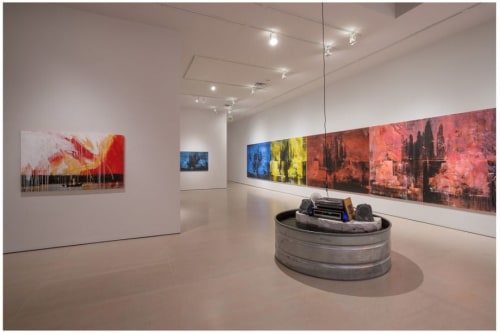
Photo: McClain Gallery
How to become famous fast when you're not yet a somebody in New York's high stakes art world? Don't tell anyone your name. Make yourself mythical. Establish a collaborative so one person won't have to shoulder all the pressure. Make art about art history, and do it all - painting, printing, sculpture, video, performance. Invent a biography that invokes Robert Smithson, Roland Barthes, Andy Warhol and Joseph Beuys but also personalities some people might have to Google, such as Chris Burden and Edward Said. Invite friends, especially if they're rich and date A-list celebrities. Stage your first show as a retrospective.
The Bruce High Quality Foundation seems to have it down. The collaborative is named for a fictional artist whose work was supposedly lost with the World Trade Centers on Sept. 11, 2001. Late last month, the collaborative filled the prestigious front room of Houston's McClain Gallery with a show of large, many-layered mixed-media works that riff on Arnold Böcklin's late 19th-century "Isle of the Dead," substituting the Hudson River, a garbage dump and the New York skyline for the original's dreamy setting.
The big works are stunning, especially when you can hear the music emanating from a record player that floats on a Styrofoam island in a galvanized tank filled with water: Sergei Rachmaninoff's "Isles of the Dead" loops continuously. The effect is infinitely cooler than that "Nightmare on the Bayou" spectacle that jammed traffic on Studemont for a few nights.
In a back room, the guys have set up a pristine mini-museum of plaster busts on pedestals. The amusing busts are "Self Portraits" created by defacing or deconstructing classical sculptures with the foundation's signature face of smeared blue eyes, bloody-looking lips and a splash of yellow hair. They're sad, beautiful and hilarious. We could have bought the whole installation, except that the busts cost $12,000 each.
We also admired their gumption in pricing "Public Education (Let the Right One In)," an artfully scribbled-upon chalkboard with a row of tiny figurines that also have the funny face - and a price tag of $100,000. A version was hung at the Alabama Ice House for a few days, where anybody could mess with it. Art dealer Robert McClain is impressed with how the Bruce High Quality Foundation quickly got itself out of the emerging-artist category.
"They're really interested in tackling ideas. Everything they do is so smart and witty," said his gallery co-director, Erin Siudzinski.
Two of the foundation artists were there. They prefer not to see their names or even their faces in print. They don't look anything like their self-portrait. When PaperCity asked to take their picture, they posed with their backs to the camera. Their pal Vito Schnabel was there, too. The son of artist Julian Schnabel, he's an art dealer and restaurateur who's perhaps more widely known online right now as "Heidi Klum's toy boy." He didn't mind being shown from the front.
The next night, one of the artists, without sharing his name, showed some of their videos at the Contemporary Arts Museum Houston. The videos, thick with pop-culture references, try to be political.
When it isn't busy showing at blue-chip galleries, BHQF tries to subvert the traditional art system. It has staged a series of huge, open call shows it calls "Brucennials." The collaborative runs a free art school in New York's East Village. It also embraces the impossible: One ongoing project involves re-creating 17,232 objects from the Metropolitan Museum of Art.
"At our current rate, we will finish sometime after all of us are dead," the nameless one said.
Some of Houston's best-known artists listened attentively.